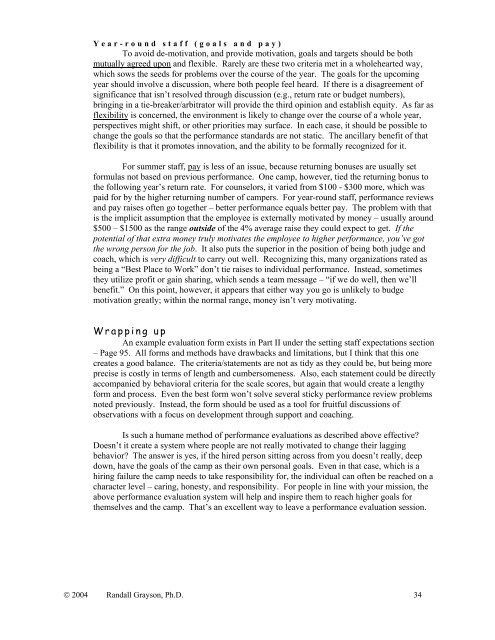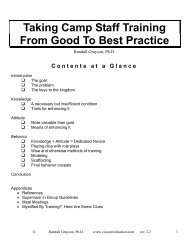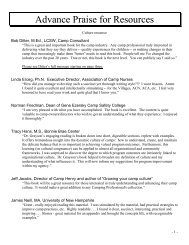Staff motivation - Vision Realization
Staff motivation - Vision Realization
Staff motivation - Vision Realization
Create successful ePaper yourself
Turn your PDF publications into a flip-book with our unique Google optimized e-Paper software.
Year-round staff (goals and pay)<br />
To avoid de-<strong>motivation</strong>, and provide <strong>motivation</strong>, goals and targets should be both<br />
mutually agreed upon and flexible. Rarely are these two criteria met in a wholehearted way,<br />
which sows the seeds for problems over the course of the year. The goals for the upcoming<br />
year should involve a discussion, where both people feel heard. If there is a disagreement of<br />
significance that isn’t resolved through discussion (e.g., return rate or budget numbers),<br />
bringing in a tie-breaker/arbitrator will provide the third opinion and establish equity. As far as<br />
flexibility is concerned, the environment is likely to change over the course of a whole year,<br />
perspectives might shift, or other priorities may surface. In each case, it should be possible to<br />
change the goals so that the performance standards are not static. The ancillary benefit of that<br />
flexibility is that it promotes innovation, and the ability to be formally recognized for it.<br />
For summer staff, pay is less of an issue, because returning bonuses are usually set<br />
formulas not based on previous performance. One camp, however, tied the returning bonus to<br />
the following year’s return rate. For counselors, it varied from $100 - $300 more, which was<br />
paid for by the higher returning number of campers. For year-round staff, performance reviews<br />
and pay raises often go together – better performance equals better pay. The problem with that<br />
is the implicit assumption that the employee is externally motivated by money – usually around<br />
$500 – $1500 as the range outside of the 4% average raise they could expect to get. If the<br />
potential of that extra money truly motivates the employee to higher performance, you’ve got<br />
the wrong person for the job. It also puts the superior in the position of being both judge and<br />
coach, which is very difficult to carry out well. Recognizing this, many organizations rated as<br />
being a “Best Place to Work” don’t tie raises to individual performance. Instead, sometimes<br />
they utilize profit or gain sharing, which sends a team message – “if we do well, then we’ll<br />
benefit.” On this point, however, it appears that either way you go is unlikely to budge<br />
<strong>motivation</strong> greatly; within the normal range, money isn’t very motivating.<br />
Wrapping up<br />
An example evaluation form exists in Part II under the setting staff expectations section<br />
– Page 95. All forms and methods have drawbacks and limitations, but I think that this one<br />
creates a good balance. The criteria/statements are not as tidy as they could be, but being more<br />
precise is costly in terms of length and cumbersomeness. Also, each statement could be directly<br />
accompanied by behavioral criteria for the scale scores, but again that would create a lengthy<br />
form and process. Even the best form won’t solve several sticky performance review problems<br />
noted previously. Instead, the form should be used as a tool for fruitful discussions of<br />
observations with a focus on development through support and coaching.<br />
Is such a humane method of performance evaluations as described above effective?<br />
Doesn’t it create a system where people are not really motivated to change their lagging<br />
behavior? The answer is yes, if the hired person sitting across from you doesn’t really, deep<br />
down, have the goals of the camp as their own personal goals. Even in that case, which is a<br />
hiring failure the camp needs to take responsibility for, the individual can often be reached on a<br />
character level – caring, honesty, and responsibility. For people in line with your mission, the<br />
above performance evaluation system will help and inspire them to reach higher goals for<br />
themselves and the camp. That’s an excellent way to leave a performance evaluation session.<br />
© 2004 Randall Grayson, Ph.D. 34





